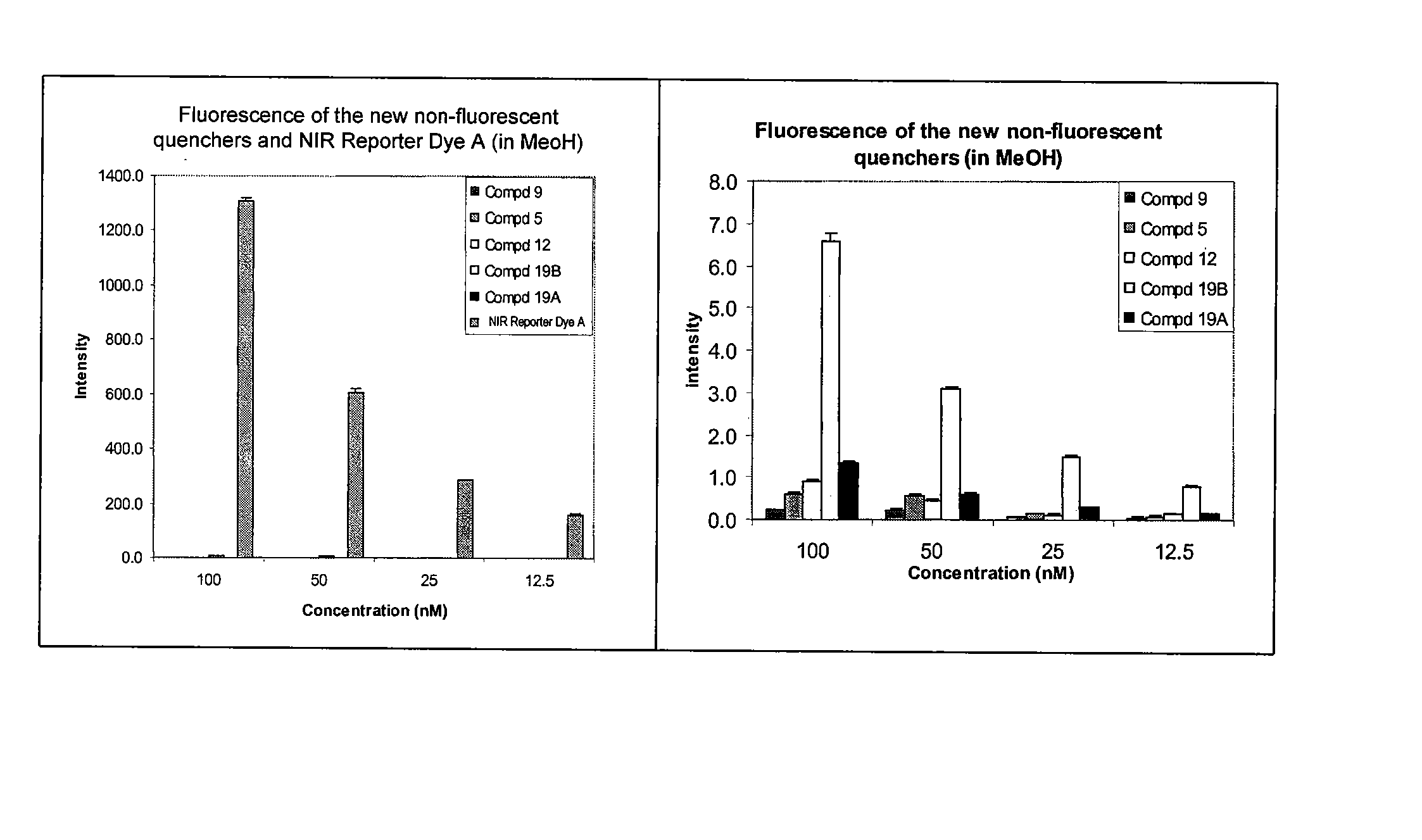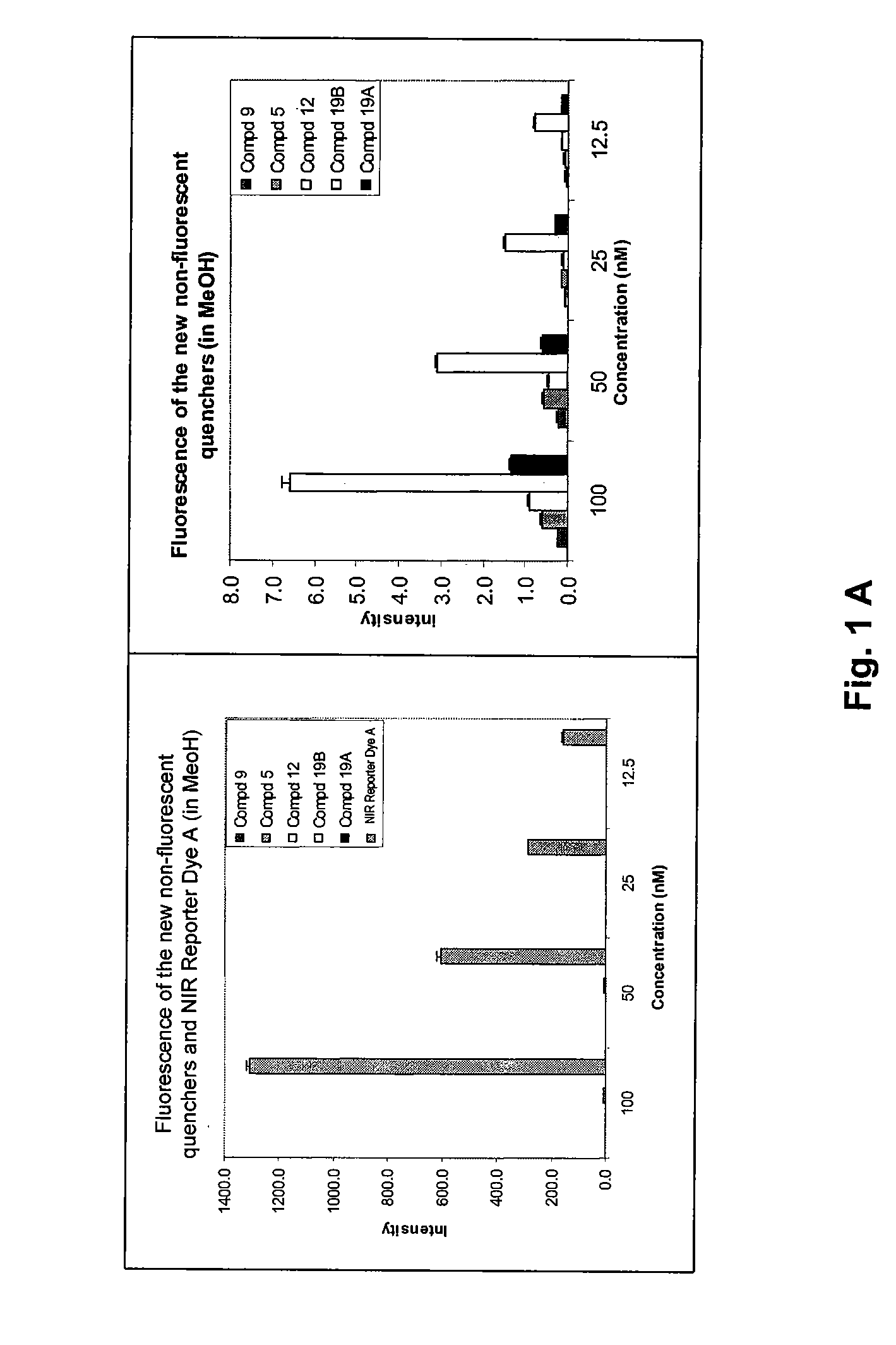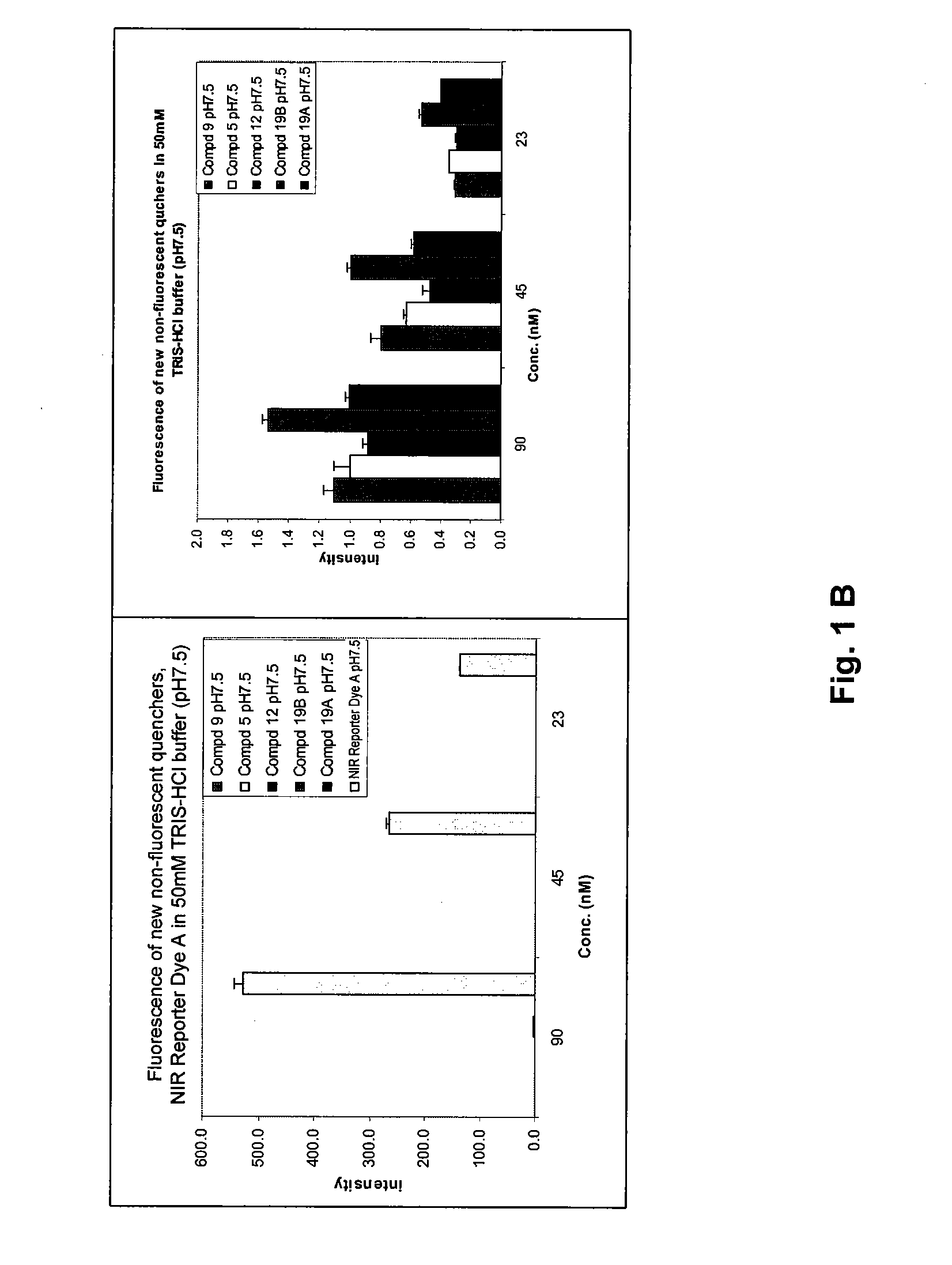Cyanine dyes and methods of use
a technology of cyanine dyes and dyes, applied in the field of cyanine dyes and methods of use, can solve the problems of hindering the utility of current assays, low assay sensitivity, and limited number of discrete wavelengths of commercial diodes lasers, and achieves efficient quenching of fluorescence, good water solubility, and little or no intrinsic fluorescence
- Summary
- Abstract
- Description
- Claims
- Application Information
AI Technical Summary
Benefits of technology
Problems solved by technology
Method used
Image
Examples
example 1
[0203] Preparation of Cyanine Dyes 5, 6 and 7:
[0204] Preparation of 5-nitro-2,3,3-trimethylindole (1). 5-nitro-2,3,3-trimethylindole (1) was synthesized according to a modified literature procedure (see, Noland, W. E., et al., J. Org. Chem. 3457-3469, 1965). To a solution of 2,3,3-trimethylindole (10.6 g) in concentrated sulfuric acid cooled to 0° C. using an ice / brine bath was added dropwise fuming nitric acid (5.6 mL). The resultant solution was stirred at 0° C. for 1.5 hours; then poured into crushed ice; filtered; and washed with water. The combined filtrate was neutralized to a pH greater than 7. The product precipitated from the neutralized solution and was collected by filtration, washed with water, and dried to provide the desired product 1 (10.1 g, 74% yield): ESI-MS, calculated [M+H]+ 205.1, found 205.0.
[0205] Preparation of 5-amino-2,3,3-trimethylindole (2). To the solution of 5-nitro-2,3,3-trimethylindole (1) (10 g) in EtOH (50 mL), hydrazine (35% in water, 6.72 g) wa...
example 2
[0210] Preparation of Cyanine Dyes 9 and 10:
[0211] Preparation of compound 9. Compound 3 (810 mg), N-(ε-carboxypentenyl)-1,1,2-trimethylbenzo[e]indolium 8 (487 mg) and N-[(3-(anilinomethylene)-2-chloro-1-cyclohexen-1-yl)methylene]aniline monohydrochloride (539 mg) were dissolved in methoxyethanol (10 mL) and triethylamine (1.5 mL) and stirred at 70° C. under nitrogen for 16 hours. The reaction mixture was concentrated by rotary evaporation, purified by reverse phase-high pressure liquid chromatography (RP-HPLC) and further purified by preparative HPLC. The product was ion-exchanged (sodium form ion-exchange resin) and dried to provide the desired product 9 (18 mg): UV-Vis, λmax (MeOH) 793 nm; ESI-MS (m / z), calculated [M-2Na++3H]+ 1000.3, found 1000.6.
[0212] Preparation of compound 10. Compound 9 and N,N′-disuccinimidyl carbonate is dissolved in N,N-dimethylformamide (anhydrous, amine-free) and dimethylsulfoxide (anhydrous) and is stirred at room temperature for 2 hours under argo...
example 3
[0213] Preparation of Cyanine Dyes 12 and 13:
[0214] Preparation of compound 12. Compound 3 (29 mg), N-(E-carboxypentenyl)-1,1,2-trimethyl-6,8-di-(sulfonato)-benzo[e]indolium-bis sodium salt (11) (28 mg) and N-[(3-(anilinomethylene)-2-chloro-1-cyclohexen-1-yl)methylene]aniline monohydrochloride (19 mg), was dissolved in methoxyethanol (1 mL) and triethylamine (50 mL) and stirred at 70° C. under nitrogen atmosphere for 16 hours. The product is collected by ethyl ether precipitation and purified on RP-HPLC and concentrated to provide the desired product 12 (2 mg): UV-Vis, λmax (MeOH) 790 nm; ESI-MS (m / z) calculated [M-5Na++6H+]+ 1160.2, found 1160.3.
[0215] Preparation of compound 13. Compound 12 and N,N′-disuccinimidyl carbonate are diluted in N,N-dimethylformide (anhydrous, amine-free) and dimethylsulfoxide (anhydrous) and the resultant solution is stirred at room temperature under argon atmosphere for 2 hours. The precipitated product is isolated by centrifuge and the product 13 i...
PUM
| Property | Measurement | Unit |
|---|---|---|
| Time | aaaaa | aaaaa |
| Fraction | aaaaa | aaaaa |
| Nanoscale particle size | aaaaa | aaaaa |
Abstract
Description
Claims
Application Information
 Login to View More
Login to View More - R&D
- Intellectual Property
- Life Sciences
- Materials
- Tech Scout
- Unparalleled Data Quality
- Higher Quality Content
- 60% Fewer Hallucinations
Browse by: Latest US Patents, China's latest patents, Technical Efficacy Thesaurus, Application Domain, Technology Topic, Popular Technical Reports.
© 2025 PatSnap. All rights reserved.Legal|Privacy policy|Modern Slavery Act Transparency Statement|Sitemap|About US| Contact US: help@patsnap.com



